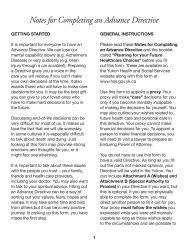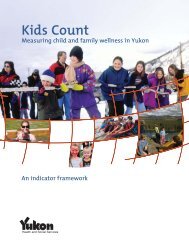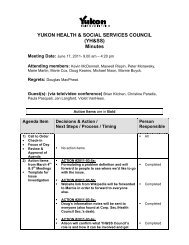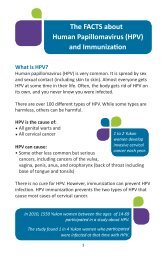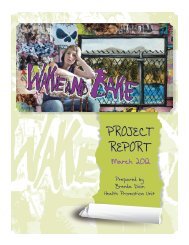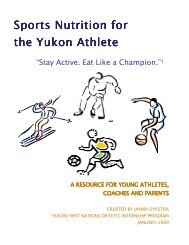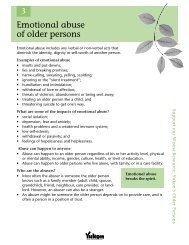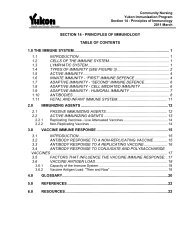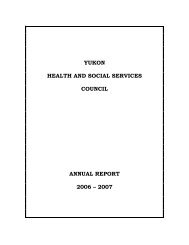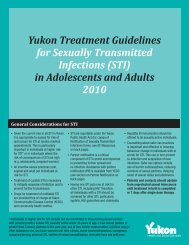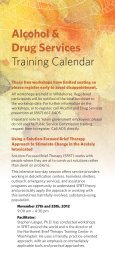Blood & Body Fluid Exposure Management - Health and Social ...
Blood & Body Fluid Exposure Management - Health and Social ...
Blood & Body Fluid Exposure Management - Health and Social ...
You also want an ePaper? Increase the reach of your titles
YUMPU automatically turns print PDFs into web optimized ePapers that Google loves.
Where to access<br />
care<br />
Who to consult<br />
<strong>and</strong> when<br />
Please consult<br />
whenever questions<br />
arise on how to<br />
proceed with postexposure<br />
management <strong>and</strong><br />
when exposure is<br />
beyond the scope of<br />
guidelines.<br />
<strong>Blood</strong> <strong>and</strong> <strong>Body</strong> <strong>Fluid</strong> <strong>Exposure</strong> <strong>Management</strong><br />
Yukon Communicable Disease Control<br />
#4 Hospital Rd., Whitehorse, YT Y1a 3H8<br />
Phone: 667-8323 Fax: 667-8349<br />
Quick Reference Sheets—<strong>Blood</strong> <strong>and</strong> <strong>Body</strong> <strong>Fluid</strong> <strong>Exposure</strong> <strong>Management</strong><br />
Whitehorse:<br />
YCDC<br />
#4Hospital Rd.<br />
Whitehorse<br />
M-F Hours: 0830-1630<br />
Phone: (867) 667-8323<br />
Revised April 2013<br />
WGH ER<br />
#5 Hospital Rd.<br />
Whitehorse<br />
Phone: (867) 393-8700<br />
Outside of Whitehorse: Local Community <strong>Health</strong> Centre/Clinic/ER<br />
Yukon RNs Consult:<br />
YCDC: (867) 667-8323 Monday - Friday 0830-1630hrs<br />
*Indicate call is regarding BBF post exposure<br />
management.<br />
After Hours<br />
Contact WGH-ER Physician on call: (867) 393-8700,<br />
or Community physician.<br />
MOH may be consulted after calling ER physician<br />
Work (867) 456-6136 or cell (867) 332-1160<br />
WGH Occupational <strong>Health</strong><br />
Practitioner ( WGH employees/inpatients)<br />
M-F Hours: 0800-1600<br />
Phone: (867) 393-8933<br />
Yukon Physicians Consult:<br />
YCDC: (867) 667-8323<br />
Monday - Friday 0830-1630hrs<br />
*Indicate call is regarding BBF post exposure<br />
management<br />
or<br />
MOH work (867)456-6136 or cell (867) 332-1160<br />
BC Centre for Excellence in HIV/AIDS (consultation service available 24 hours a day 7 days aweek)<br />
Monday – Friday (0800 – 1700) Tel: 604-806-8429. After hours & Weekends Tel: 604-341-1410<br />
<strong>Management</strong><br />
Cleanse<br />
Mucous membrane or eye: Rinse well with water <strong>and</strong>/or normal saline<br />
Skin: Wash well with soap <strong>and</strong> water.<br />
Allow injury/wound site to bleed freely, <strong>and</strong> then cover lightly.<br />
Do not promote bleeding of percutaneous injuries by cutting, scratching, squeezing, or puncturing the skin.<br />
Do not apply bleach to the injury/wound or soak it in bleach.<br />
Triage Are the four indications present for post-exposure management? See attached algorithm pg. 2<br />
Refer to<br />
attached charts<br />
Assess risk of<br />
transmission from<br />
the source<br />
Determine<br />
status of the<br />
exposed person<br />
Counsel<br />
Access HBIG<br />
Availability of<br />
antiretroviral<br />
starter kits<br />
Arrange lab F/U<br />
for exposed<br />
person<br />
Exposed Person: <strong>Blood</strong> <strong>and</strong> body fluid exposure management algorithm; See attached pg. 2<br />
Stratification of HIV <strong>Exposure</strong>s; See attached pg. 4<br />
Hepatitis B Post <strong>Exposure</strong> Prophylaxis; See attached pg. 5<br />
Testing Schedule for a person exposed to HCV; See attached pg. 3<br />
If source is known attempts should be made to have source person tested<br />
Obtain source person’s consent <strong>and</strong> test for: anti-HIV, anti-HCV, HBsAg, Anti-HBs, Anti-HBc<br />
Refer to attached table: Indicators for increased risk of transmission from the source to the exposed<br />
person; See attached pg. 8<br />
DO NOT WAIT FOR TEST RESULTS BEFORE COMMENCING TREATMENT (if indicated)<br />
Obtain consent for baseline testing which may include: anti-HIV, anti-HCV, HBsAg, Anti-HBs, Anti-HBc<br />
Refer to Counselling Guidelines: <strong>Management</strong> of <strong>Blood</strong> <strong>and</strong> <strong>Body</strong> <strong>Fluid</strong>s Post <strong>Exposure</strong> pg. 36 <strong>and</strong> Probability of<br />
Transmission pg. 38<br />
Whitehorse: Physicians request HBIG from the WGH laboratory for administration in WGH ER<br />
Afterhours: call WGH A&D to have the on-call laboratory personnel paged<br />
Outside of Whitehorse: A supply of HBIG is kept in the following communities: Beaver Creek, Ross River,<br />
Haines Junction, Dawson City, Old Crow, Mayo, Watson Lake<br />
If HBIG is not stocked in the community requiring it, arrangements will be made to have it provided from the most<br />
feasible location<br />
Whitehorse: Starter kits (5 day supply) oftherapyareavailable at the WGH ER <strong>and</strong> YCDC<br />
Outside of Whitehorse: One starter kit is supplied in each community health centre<br />
*To arrange for remainder of 23 day antiretroviral therapy – call YCDC (867) 667-8323<br />
Refer to attached Chart: Testing of the Exposed Person; See attached pgs. 3 & 6<br />
Complete last page of the <strong>Blood</strong> <strong>and</strong> <strong>Body</strong> <strong>Fluid</strong> <strong>Exposure</strong> Form (BBFE) form <strong>and</strong> give to client; See<br />
attached pg. 9<br />
Documentation Complete the <strong>Blood</strong> <strong>and</strong> <strong>Body</strong> <strong>Fluid</strong> <strong>Exposure</strong> Form (BBFE); see attached pgs. 10 & 11<br />
Captures: exposure details, examination of injury, management of exposed, information on source,<br />
recommendations made, follow up plan of care<br />
Occupational <strong>Exposure</strong>: Worker’s Compensation Board (WCB) Forms<br />
Where to send<br />
BBFE form<br />
Copy to YCDC Fax: (867) 667-8349<br />
Copy to exposed person’s follow up physician<br />
Provide client with the last page–summary of initial management <strong>and</strong> plan for follow up; see attached pg. 9<br />
1
<strong>Blood</strong> <strong>and</strong> <strong>Body</strong> <strong>Fluid</strong> <strong>Exposure</strong> <strong>Management</strong><br />
Yukon Communicable Disease Control<br />
#4 Hospital Rd., Whitehorse, YT Y1a 3H8<br />
Phone: 667-8323 Fax: 667-8349<br />
<strong>Blood</strong> <strong>and</strong> <strong>Body</strong> <strong>Fluid</strong> <strong>Exposure</strong> <strong>Management</strong> Algorithm:<br />
Exposed Person: Guidelines pg. 8<br />
Are the four indications present for post-exposure<br />
management?<br />
percutaneous, mucosal or non-intact skin<br />
exposure to blood or infectious body fluids<br />
potentially infectious source<br />
susceptible exposed person<br />
Yes<br />
No<br />
Assess risk of the source for HIV,<br />
HBV <strong>and</strong> HCV<br />
Refer to Appendix B: Risk Factors for<br />
Possible Transmission<br />
No post exposure management required<br />
Provide education, counseling or advice<br />
as appropriate<br />
HIV HBV HCV<br />
Obtain baseline<br />
anti – HIV<br />
Assess eligibility<br />
for PEP<br />
Refer toTable 3,<br />
pg 16: Stratification<br />
of HIV <strong>Exposure</strong><br />
Significant risk:<br />
Start PEP:<br />
Refer to Table 1,<br />
pg 13:Testing of the<br />
Exposed Person<br />
Complete baseline<br />
serology<br />
Determine HBV<br />
susceptibility<br />
Refer to Table 4, pg 21:<br />
Hepatitis B Post-<br />
<strong>Exposure</strong> prophylaxis<br />
Negligible Risk:<br />
No PEP<br />
Complete:<br />
3, 6 week <strong>and</strong> 3, 6<br />
month serology<br />
Complete baseline Anti- HCV serology<br />
Note: There is no initial PEP for HCV<br />
Source<br />
Unknown<br />
Complete 3<br />
<strong>and</strong> 6 month,<br />
serology<br />
(Anti HCV)<br />
Negative:<br />
Complete 3 <strong>and</strong> 6<br />
month serology<br />
(Anti HCV)<br />
Source<br />
HCV -ve<br />
Complete 3<br />
<strong>and</strong> 6 month<br />
Serology<br />
(Anti HCV)<br />
Source<br />
Known<br />
Source<br />
HCV +ve<br />
or High<br />
Risk<br />
Complete 3<br />
week HCV<br />
RT-PCR<br />
Positive:<br />
Repeat PCR test to<br />
confirm result on a<br />
separate specimen<br />
*Antiretrovirals are not recommended for needlesticks from an<br />
ab<strong>and</strong>oned needle in a community setting when there is no history<br />
of the origin of the needle or the time of its ab<strong>and</strong>onment.<br />
If positive, active infection is<br />
confirmed - consult with YCDC<br />
about monitoring <strong>and</strong> treatment<br />
options<br />
2
<strong>Blood</strong> <strong>and</strong> <strong>Body</strong> <strong>Fluid</strong> <strong>Exposure</strong> <strong>Management</strong><br />
Yukon Communicable Disease Control<br />
#4 Hospital Rd., Whitehorse, YT Y1a 3H8<br />
Phone: 667-8323 Fax: 667-8349<br />
Testing of the Exposed Person Guidelines pg. 13<br />
TIME SINCE<br />
EXPOSURE<br />
Anti-<br />
HIV<br />
Anti-HCV HCV PCR HBsAg Anti- Anti-<br />
HBs HBc <br />
RATIONALE FOR<br />
TESTING OF THE<br />
EXPOSED PERSON<br />
ASAP <br />
<br />
<br />
To check baseline status<br />
of the exposed person.<br />
Negative or non-reactive<br />
test results suggest no<br />
prior infection.<br />
3 weeks after<br />
exposure<br />
If source is HCV+ or in a<br />
high risk group, test<br />
exposed person for HCV<br />
infection by RT-PCR )<br />
If HCV RT-PCR +, early<br />
treatment may be<br />
beneficial. If the exposed<br />
person is confirmed<br />
PCR+, active infection is<br />
present <strong>and</strong> there is no<br />
need to test for anti-HCV.<br />
6 weeks after<br />
exposure<br />
3 months after<br />
exposure<br />
6 months after<br />
exposure<br />
<br />
<br />
<br />
To check whether<br />
seroconversion has<br />
occurred. A change from<br />
the initial negative (or<br />
non-reactive) test result to<br />
a positive (or reactive)<br />
result indicates that<br />
seroconversion has<br />
occurred. Seroconversion<br />
following a blood or body<br />
fluid exposure does not<br />
definitively establish that<br />
the exposure was the<br />
source of the virus if the<br />
exposed person has other<br />
risk factors.<br />
If the source person tests negative for HBV, HCV, <strong>and</strong> HIV <strong>and</strong> is not in a high-risk group, only<br />
baseline testing of the exposed person is indicated.<br />
See Table 4, pg. 21: Hepatitis B Post-<strong>Exposure</strong> Prophylaxis<br />
If PCR+, a second sample needs to be tested to confirm the result.<br />
Note: If the exposed person is a pregnant woman, request HBV testing as close to delivery as<br />
possible.<br />
3
<strong>Blood</strong> <strong>and</strong> <strong>Body</strong> <strong>Fluid</strong> <strong>Exposure</strong> <strong>Management</strong><br />
Yukon Communicable Disease Control<br />
4 Hospital Rd., Whitehorse, YT. Y1A 3H8<br />
Phone: 667-8323 Fax: 667-8349<br />
Stratification of HIV <strong>Exposure</strong>s: Guidelines pg. 16<br />
EXPOSURE RISK TYPE OF EXPOSURE RECOMMENDATION<br />
SIGNIFICANT RISK: Any percutaneous exposure to infectious Antiretroviral starter kit (5<br />
body fluids <br />
day kit)<br />
<br />
Infectious body<br />
fluid <strong>and</strong> an HIV<br />
positive source or<br />
a known high-risk<br />
source. (See<br />
Appendix B in<br />
Guideline)<br />
Mucous membrane or non-intact<br />
skin exposure (3 or more drops for<br />
3 or more minutes)<br />
In the event of a large prolonged<br />
exposure of blood on intact skin,<br />
assess the integrity of the skin. If<br />
appropriate, treat as a significant<br />
risk exposure.<br />
Consult:<br />
YCDC Weekdays 0830-<br />
1600hrs.<br />
Tel: (867)667-8323<br />
Medical Officer of <strong>Health</strong>: Dr.<br />
Brendan Hanley<br />
Tel: (867) 456-6136<br />
Cell: (867) 332-1160<br />
BC Centre for Excellence in<br />
HIV/AIDS<br />
Monday – Friday (0800 – 1700)<br />
Tel: (604) 806-8429<br />
Afterhours <strong>and</strong> weekends<br />
Tel: (604) 341-1410<br />
NEGLIGIBLE RISK:<br />
<br />
<br />
<br />
Source known or<br />
presumed to be<br />
HIV negative<br />
OR<br />
Injury not known to<br />
transmit HIV<br />
OR<br />
<strong>Body</strong> fluid not<br />
known to transmit<br />
HIV<br />
<br />
<br />
<br />
<br />
Percutaneous, mucous membrane or<br />
skin exposure to non-infectious body<br />
fluid – source HIV positive or negative.<br />
Bites unless there has clearly been<br />
transmission of infected blood.<br />
A superficial scratch that does not<br />
bleed.<br />
Injuries received in fights would rarely<br />
be appropriate indications for<br />
prophylaxis unless it is clear that<br />
transfer of infected blood has<br />
occurred.<br />
* Community Nurses – When using<br />
BC-CfE consultation service, please<br />
be advised that should HIV post<br />
exposure prophylaxis be<br />
recommended, this should be<br />
discussed <strong>and</strong> prescribed by a<br />
licensed Yukon Physician.<br />
<br />
<br />
No antiretrovirals<br />
recommended.<br />
Offer counselling<br />
clarifying the negligible<br />
risk of HIV infection <strong>and</strong><br />
advise re: risk<br />
prevention (i.e.<br />
preventing recurrences<br />
of exposure incidents).<br />
Antiretrovirals (ARTs) are not provided free to persons exposed to HIV as part of their personal lives (i.e. consensual adult sex, or sharing drug<br />
injection equipment). However, the assessing physician may elect to prescribe ARTs for these situations <strong>and</strong> should consult with YCDC or the BC<br />
Centre for Excellence in HIV/AIDS regarding which ARTs to prescribe.<br />
Note: Prophylaxis is not recommended for needlesticks from ab<strong>and</strong>oned needles when they are outside the healthcare setting or when<br />
there is no history of the needle or the time of ab<strong>and</strong>onment.<br />
. 4
<strong>Blood</strong> <strong>and</strong> <strong>Body</strong> <strong>Fluid</strong> <strong>Exposure</strong> <strong>Management</strong><br />
Yukon Communicable Disease Control<br />
#4 Hospital Rd., Whitehorse, YT Y1a 3H8<br />
Phone: 667-8323 Fax: 667-8349<br />
Hepatitis B Post-<strong>Exposure</strong> Prophylaxis: Guidelines pg. 21<br />
Vaccination history of<br />
exposed person<br />
Test exposed<br />
person for:<br />
HBsAg, anti-<br />
HBc & anti-<br />
HBs.<br />
If source is<br />
known HBsAg<br />
positive or high<br />
risk or tests<br />
positive within<br />
48 hours of<br />
exposure <br />
If source is<br />
unknown or not<br />
tested or low<br />
risk or tests<br />
HBsAG<br />
negative within 48<br />
hours of exposure (eg.<br />
Ab<strong>and</strong>oned needle)<br />
Post-exposure<br />
re-testing<br />
Documented anti-HBs level<br />
( 10 IU/L) on prior testing<br />
Test for all three<br />
markers for<br />
medical-legal<br />
purposes<br />
Unvaccinated Test for all 3<br />
markers<br />
Known non- responder to<br />
one Hep B series<br />
Received 1 dose of Hep B<br />
vaccine, anti- HBs status<br />
unknown<br />
Received 2 doses of a 3<br />
dose Hep B series, anti-HBs<br />
status<br />
unknown<br />
Complete Hep B vaccination<br />
(2 or 3 dose series) <strong>and</strong> anti-<br />
HBs status unknown or anti-<br />
HBs < 10 when<br />
tested > 6 months postseries<br />
Known non- responder<br />
after two courses of Hep B<br />
vaccine<br />
<br />
<br />
<br />
<br />
<br />
Test for all 3<br />
markers<br />
Test for all 3<br />
markers<br />
Test for all 3<br />
markers.<br />
If anti-HBs is<br />
10 IU/L, then<br />
<br />
Test for all 3<br />
markers. If anti-<br />
HBs is 10<br />
U/L, then<br />
Test for all 3<br />
markers.<br />
If anti-HBs is<br />
10 IU/L, then<br />
<br />
Test for HBsAg<br />
& anti-HBc. Do not<br />
test for anti- HBs.<br />
No action<br />
required.<br />
Give Hepatitis B<br />
Immune Globulin<br />
(HBIg) <strong>and</strong><br />
Hepatitis B<br />
vaccineseries<br />
Give HBIg &<br />
complete Hep B<br />
vaccine series.<br />
Give HBIg & 3rd<br />
dose of Hep B<br />
vaccine. Repeat<br />
3 rd dose if given too<br />
early in<br />
series.<br />
Do not give HBIg.<br />
Complete Hep B<br />
vaccine series.<br />
Give HBIg <strong>and</strong> 1<br />
dose of vaccine.<br />
Give HBIg only &<br />
give another dose<br />
of HBIg in 1 mo.<br />
No action required.<br />
Give Hep B vaccine<br />
series<br />
Give 2 nd Hep B vaccine<br />
series<br />
Complete Hep B vaccine<br />
series.<br />
Give 1 dose of Hep B<br />
vaccine & retest for anti-<br />
HBs in 4 wks; if 10<br />
IU/L repeat series.<br />
Do not give HBIg.<br />
Complete Hep B<br />
vaccine series.<br />
1 dose Hep B vaccine &<br />
retest for anti-HBs in 4wks; if<br />
10 IU/L<br />
complete second series.<br />
No action required.<br />
No action required.<br />
Re-test for HBsAg at<br />
3 months & for all 3<br />
markers at 6 months<br />
<br />
Re-test for HBsAg at<br />
3 months & for all 3<br />
markers at 6 months<br />
<br />
Re-test for HBsAg at<br />
3 months & for all 3<br />
markers at 6 months<br />
<br />
No re-testing required.<br />
Re-test for HBsAg at<br />
3 months & for all 3<br />
markers at 6 months<br />
<br />
Re-test for HBsAg<br />
at 3 months & for<br />
HBsAg & anti-HBc<br />
at 6 months.<br />
A non-responder to a series of Hepatitis B vaccine is someone who demonstrates an anti-HBs level of<br />
10 UI/L, when measured 1 to 6 months post-vaccination.<br />
Consensual adult sex with known Sex Trade Worker or IDU is not an indication for HBIg, nor is a community acquired needlestick<br />
injury: the risk of transmission is low <strong>and</strong> the number needed to treat to prevent infection is extremely high. HBIg is indicated in the case of<br />
sexual assault or if one of the individuals is known to have acute or chronic Hepatitis B infection.<br />
HBIg dose for all clients 8.3kg is 0.06ml/kg. Give HBIg as soon as possible, preferably within 48 hours of the exposure. For a percutaneous<br />
exposure, HBIg may be given up to 7days following the exposure. If the client presents 7 days following a percutaneous exposure, give<br />
Hepatitis B vaccine only. For permucosal or sexual exposures, HBIg may be given up to 14 days following the last exposure. If the client<br />
presents 14 days following a permucosal or sexual exposure, give Hepatitis B vaccine only.<br />
Hepatitis B vaccine schedule is 0, 1 <strong>and</strong> 6 months for post-exposure prophylaxis.<br />
A second series of Hepatitis B vaccine should be offered to non-responders<br />
Note: This table does not apply to post-exposure management of immunocompromised persons. This group<br />
requires consultation with a physician specializing in infectious diseases.<br />
5
<strong>Blood</strong> <strong>and</strong> <strong>Body</strong> <strong>Fluid</strong> <strong>Exposure</strong> <strong>Management</strong><br />
Yukon Communicable Disease Control<br />
#4 Hospital Rd., Whitehorse, YT Y1a 3H8<br />
Phone: 667-8323 Fax: 667-8349<br />
HCV <strong>Exposure</strong>: Guidelines pg. 23<br />
While HCV is transmitted more efficiently by the parenteral route than HIV, it is transmitted by sexual<br />
contact much less efficiently than either HBV or HIV. Transmission probabilities for HCV are<br />
summarized in Appendix N, page 38 in Guideline.<br />
At the present time, no immediate post-exposure treatment is recommended for HCV.<br />
However, the anti-HCV status of the exposed person should be determined to assess<br />
whether the person has been infected with HCV in the past.<br />
Testing schedule for a person exposed to HCV:<br />
If suspected exposure to HCV has occurred complete an anti-HCV base line test<br />
1 st Test<br />
If anti-HCV reactive *<br />
If anti-HCV non reactive<br />
2 nd Test<br />
2- 3 3 weeks after the initial initial anti-HCV anti-HCV testing, testing, if source’s if source’s<br />
Complete an immediate follow-up test for HCV RNA HCV status status is positive is positive or unknown, or source test is for in HCV a high RNA risk<br />
group, perform testing for HCV RNA to look for<br />
PCR to look for active infection<br />
should be performed to look for active infection.<br />
active infection<br />
HCV RNA PCR performed<br />
If HCV RNA PCR positive<br />
If HCV RNA PCR negative<br />
Follow up<br />
Testing<br />
Repeat PCR testing to confirm result<br />
Repeat anti-HCV anti‐HCV at: at:<br />
33 months<br />
12 6months<br />
If HCV RNA positive;<br />
If HCV RNA negative;<br />
active infection<br />
active infection not<br />
confirmed, consult with<br />
confirmed If If all anti‐HCV both anti-HCV tests<br />
a health care provider<br />
are tests negative,<br />
are negative,<br />
about monitoring <strong>and</strong><br />
transmission has<br />
has<br />
treatment options<br />
not not occurred occurred <strong>and</strong><br />
<strong>and</strong><br />
monitoring may<br />
may<br />
cease<br />
cease<br />
If either anti-HCV<br />
test is positive, active<br />
infection<br />
confirmed.<br />
Consult with a health<br />
care provider about<br />
monitoring <strong>and</strong><br />
treatment options<br />
*Anti-HCV takes about 5-10 weeks after infection to develop. If your baseline anti-HCV test is reactive, then you may have been infected in the<br />
past <strong>and</strong> a follow-up HCV RNA test can be perform to determine if you are actively infected (i.e., have the virus in your blood at the present time).<br />
6
<strong>Blood</strong> <strong>and</strong> <strong>Body</strong> <strong>Fluid</strong> <strong>Exposure</strong> <strong>Management</strong><br />
Yukon Communicable Disease Control<br />
4 Hospital Rd., Whitehorse, YT. Y1A 3H8<br />
Phone: 667-8323 Fax: 667-8349<br />
<strong>Fluid</strong>s <strong>and</strong> Tissues Capable of Transmitting <strong>Blood</strong>borne Pathogens: Guidelines pg. 24<br />
FLUID HIV HBV HCV<br />
<strong>Blood</strong> <strong>and</strong> fluids visibly<br />
contaminated with blood Yes Yes Yes<br />
Semen Yes Yes Yes *<br />
Vaginal secretions Yes Yes Yes *<br />
Pleural, amniotic,<br />
pericardial, peritoneal,<br />
synovial <strong>and</strong><br />
cerebrospinal fluids <strong>and</strong><br />
inflammatory exudates<br />
Saliva<br />
Transplanted tissue or<br />
organs<br />
Yes Yes Yes<br />
No, unless<br />
contaminated with<br />
blood<br />
Yes<br />
No, unless contaminated<br />
with blood<br />
Yes Yes Yes<br />
Breast milk Yes Plausible,<br />
particularly if<br />
nipples are<br />
cracked or<br />
bleeding or if the<br />
mother is HBeAg<br />
positive<br />
Plausible, particularly if<br />
nipples are cracked or<br />
bleeding<br />
Faeces<br />
Nasal secretions<br />
Sputum<br />
Sweat<br />
Tears<br />
Urine<br />
Vomitus<br />
No, unless they contain visible blood.<br />
*While HCV is transmitted more efficiently by the parenteral route than HIV, it is transmitted by sexual contact much less efficiently than either HBV<br />
or HIV. Transmission probabilities for HCV are summarized in the Guideline, Appendix N, page 38.<br />
7
<strong>Blood</strong> <strong>and</strong> <strong>Body</strong> <strong>Fluid</strong> <strong>Exposure</strong> <strong>Management</strong><br />
Yukon Communicable Disease Control<br />
#4 Hospital Rd., Whitehorse, YT Y1a 3H8<br />
Phone: 667-8323 Fax: 667-8349<br />
Risk Factors for Possible Transmission from the Source to the<br />
Exposed Person: Guidelines pg. 25<br />
HIV HBV HCV<br />
The source is a person<br />
who has ever had:<br />
The source is a person who<br />
has ever had:<br />
injection drug use injection drug use <strong>and</strong>/or<br />
inhalational drug use <br />
<br />
high-risk sexual<br />
behaviour (i.e., multiple<br />
sex partners, anal sex)<br />
<br />
high-risk sexual behaviour<br />
(i.e., multiple sex partners,<br />
anal sex)<br />
The source is a person who has ever<br />
had:<br />
<br />
<br />
injection drug use <strong>and</strong>/or inhalational drug<br />
use <br />
high-risk sexual behaviour (i.e. multiple sex<br />
partners, anal sex)<br />
<br />
a sexual partner who is<br />
an injection drug user<br />
(IDU), or who is HIV+<br />
<br />
a sexual partner who is an<br />
IDU, or who has acute or<br />
chronic HBV <br />
<br />
a sexual partner who is an IDU, or who is<br />
HCV+ <br />
<br />
blood contact with a<br />
known case of HIV<br />
infection<br />
<br />
blood contact with a known case<br />
of HBV infection for which there<br />
was no provision of postexposure<br />
prophylaxis<br />
<br />
blood contact with a known case of<br />
HCV infection<br />
<br />
<br />
emigration from a<br />
country where HIV is<br />
endemic<br />
a history of multiple<br />
transfusions of blood or<br />
blood products prior to<br />
Nov. 1985 OR a history<br />
of receipt of blood-derived<br />
coagulation products<br />
before July 1988<br />
<br />
<br />
emigration from a country<br />
where HBV is endemic<br />
a history of multiple<br />
transfusions of blood or blood<br />
products prior to Jan. 1972 <br />
OR a history of receipt of bloodderived<br />
coagulation products<br />
before January 1972<br />
<br />
a history of multiple transfusions of blood<br />
or blood products prior to May 1992 OR<br />
a history of receipt of blood-derived<br />
coagulation products before July 1988 or a<br />
history of receipt of IV immunoglobulin<br />
products prior to 1997<br />
<br />
a diagnosis of<br />
sexually transmitted<br />
disease(s)<br />
<br />
a diagnosis of sexually<br />
transmitted disease(s)<br />
<br />
tattoo, body piercing,<br />
electrolysis, acupuncture<br />
<br />
tattoo, body piercing,<br />
electrolysis, acupuncture<br />
<br />
tattoo, body piercing, electrolysis,<br />
acupuncture<br />
a history of dialysis a history of dialysis a history of dialysis<br />
In Canada, testing of donated blood for anti-HIV began in November 1985; for HBsAg in January 1972; <strong>and</strong> for<br />
anti-HCV first generation in June 1990 <strong>and</strong> anti-HCV second generation in May 1992.<br />
All factor concentrates distributed in Canada were heat treated after July 1988. IV immunoglobulin products<br />
were either PCR tested for HCV or had solvent detergent virucidal treatment after 1997<br />
High risk examples include snorting <strong>and</strong> sniffing of cocaine <strong>and</strong> smoking crack pipes.<br />
8
<strong>Blood</strong> <strong>and</strong> <strong>Body</strong> <strong>Fluid</strong> <strong>Exposure</strong> <strong>Management</strong><br />
Yukon Communicable Disease Control<br />
#4 Hospital Rd., Whitehorse, YT Y1a 3H8<br />
Phone: 667-8323 Fax: 667-8349<br />
Yukon Communicable D is e a s e Control<br />
Exposed Person’s Follow up Plan for Post <strong>Exposure</strong><br />
to <strong>Blood</strong> & <strong>Body</strong> <strong>Fluid</strong>s: Guidelines pg. 35<br />
was seen at<br />
Name Date o f Birth location of <strong>Health</strong> Care Facility<br />
on<br />
Date<br />
following an exposure to blood or body fluids.<br />
Initial assessment was done by<br />
Name of initial <strong>Health</strong> Care Provider<br />
The date of exposure was<br />
You received the following post-exposure treatment:<br />
Wound cleaning<br />
Started on antiretroviral starter kit (5 days)<br />
Tetanus Immunization<br />
Hepatitis B Vaccine<br />
List medications name, dose, & instructions<br />
Hepatitis B immune globulin (HBIG)<br />
Initial counseling f or blood <strong>and</strong> body f luid exposure<br />
Other<br />
You have had baseline <strong>Blood</strong> tests for: Hepatitis B Hepatitis C HIV<br />
Your follow up <strong>Health</strong> Care Provide r is: Location of <strong>Health</strong> Care Facility Phone Number<br />
It is recommended that you have the following follow up:<br />
(Check all that may apply).<br />
Follow up is recommended for: Location for follow -up Date<br />
Further doses of Hepatitis B vaccine<br />
Hepatitis B Immune Globulin (HBIG)<br />
You have been started on HIV antiretroviral medications. You must see your f ollow up <strong>Health</strong><br />
Care Provider within 3 days to determine if you should continue taking the medication f or a<br />
remaining 23 days<br />
Results of baseline blood tests.<br />
Follow up blood work<br />
Other (specify)<br />
For information related to exposure of blood <strong>and</strong> body f luids <strong>and</strong> disease specific information please visit<br />
http://www.healthlinkbc.ca/healthfiles/hfile97.stm<br />
If you have any questions or concerns please contact your follow up <strong>Health</strong> Care Provider or<br />
YG (5673Q) F1 02/2010 YCDC at #4 Hospital Road Whitehorse, YT Y1A 3H8 Tel: (867) 667-8323<br />
9
<strong>Blood</strong> <strong>and</strong> <strong>Body</strong> <strong>Fluid</strong> <strong>Exposure</strong> <strong>Management</strong><br />
Yukon Communicable Disease Control<br />
#4 Hospital Rd., Whitehorse, YT Y1a 3H8<br />
Phone: 667-8323 Fax: 667-8349<br />
10
<strong>Blood</strong> <strong>and</strong> <strong>Body</strong> <strong>Fluid</strong> <strong>Exposure</strong> <strong>Management</strong><br />
Yukon Communicable Disease Control<br />
#4 Hospital Rd., Whitehorse, YT Y1a 3H8<br />
Phone: 667-8323 Fax: 667-8349<br />
11


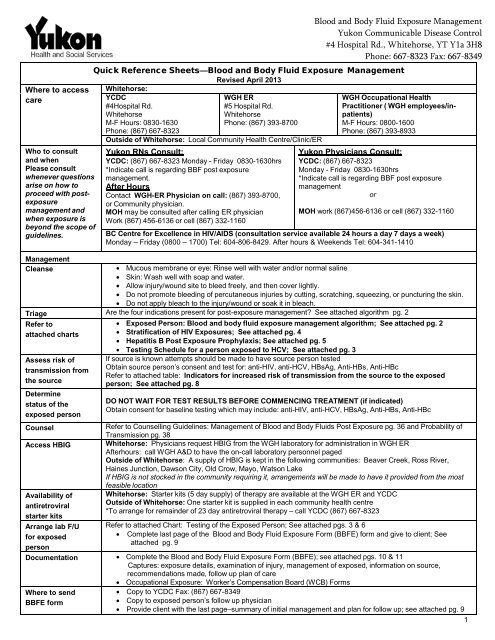
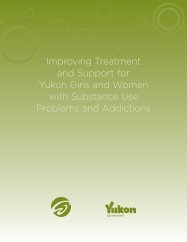
![Women and Alcohol: A women's health resource [2326.26 KB ]](https://img.yumpu.com/22340649/1/190x245/women-and-alcohol-a-womens-health-resource-232626-kb-.jpg?quality=85)
